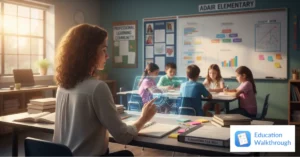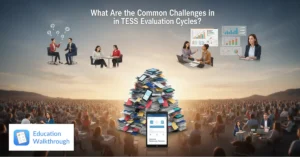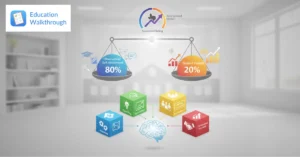The Charlotte Danielson Framework for Teaching is a widely recognized tool used in the education field to evaluate and improve teaching practices. It is divided into five domains, each focusing on different aspects of teaching. Understanding and mastering these domains can significantly enhance instructional effectiveness and student learning outcomes.
Domain 1: Planning and Preparation
Effective teaching begins with thorough planning and preparation. This domain emphasizes the importance of understanding the content, setting instructional goals, and designing coherent instruction.
Understanding Content and Pedagogy
Teachers need a deep understanding of the subjects they teach. This includes staying updated with the latest developments in the field and knowing how to convey complex concepts in an understandable way. Additionally, effective pedagogy involves choosing the right teaching methods and materials to engage students.
Setting Instructional Goals
Instructional goals should be clear, achievable, and aligned with curriculum standards. Teachers need to set both short-term and long-term goals that cater to the diverse needs of their students. Well-defined goals help in creating a roadmap for instruction, ensuring that teaching is focused and purposeful.
Designing Coherent Instruction
Coherent instruction involves creating lesson plans that are logically structured and sequenced. Lessons should build on prior knowledge and progressively introduce new concepts. Effective instruction design also incorporates a variety of teaching strategies to address different learning styles.
Assessing Student Learning
Teachers must plan for assessment as an integral part of the instructional process. This includes designing formative and summative assessments that accurately measure student learning. Regular assessment helps in identifying areas where students need additional support and adjusting instruction accordingly.

Utilizing Resources
Effective planning includes the strategic use of available resources. Teachers should leverage textbooks, digital tools, and community resources to enhance learning experiences. Knowing how to find and use these resources effectively can make lessons more engaging and informative.
Domain 2: The Classroom Environment
Creating a positive classroom environment is crucial for student success. This domain focuses on managing classroom procedures, fostering a respectful culture, and ensuring a safe learning space.
Establishing a Culture of Respect
A respectful classroom culture is foundational to effective learning. Teachers should model respect and encourage positive interactions among students. Establishing clear expectations for behavior and consistently enforcing them helps maintain a respectful environment.
Managing Classroom Procedures
Efficient classroom procedures are essential for minimizing disruptions and maximizing instructional time. This includes routines for daily activities, transitions, and handling materials. Well-managed procedures help students know what to expect and allow the teacher to focus more on instruction.
Organizing Physical Space
The physical arrangement of the classroom can impact student engagement and learning. Teachers should organize the space to facilitate interaction, collaboration, and easy access to materials. A well-organized classroom can enhance the overall learning experience.
Building a Learning Community
Creating a sense of community in the classroom helps students feel connected and valued. Teachers can foster this by encouraging collaboration, celebrating diversity, and promoting a growth mindset. A strong learning community supports academic and social-emotional development.
Promoting Student Responsibility
Encouraging students to take responsibility for their learning fosters independence and accountability. Teachers can promote this by providing opportunities for student choice, self-assessment, and goal setting. When students take ownership of their learning, they become more engaged and motivated.
Domain 3: Instruction
Effective instruction is the heart of teaching. This domain covers the delivery of instruction, engaging students, and using assessment to guide teaching.
Communicating Clearly
Clear communication is essential for effective teaching. This involves explaining concepts in a way that students can understand, providing clear directions, and using questioning techniques to stimulate thinking. Good communication helps students grasp the material and stay engaged.
Engaging Students in Learning
Engagement is critical for student success. Teachers can engage students by using a variety of instructional strategies, incorporating technology, and connecting lessons to real-world contexts. Active learning experiences keep students interested and motivated.

Using Assessment in Instruction
Ongoing assessment is vital for informing instruction. Teachers should use formative assessments to gauge student understanding and adjust teaching methods as needed. Summative assessments help evaluate overall learning and inform future instruction.
Differentiating Instruction
Differentiation involves tailoring instruction to meet the diverse needs of students. This can include providing different levels of support, using varied teaching methods, and offering choices in learning activities. Differentiated instruction helps all students succeed.
Providing Feedback
Timely and constructive feedback is crucial for student growth. Teachers should provide specific, actionable feedback that helps students understand their strengths and areas for improvement. Effective feedback supports learning and encourages students to take an active role in their education.
Domain 4: Professional Responsibilities
Professional responsibilities extend beyond the classroom. This domain focuses on reflecting on teaching, maintaining accurate records, and engaging in professional development.
Reflecting on Teaching
Reflection is a key component of professional growth. Teachers should regularly evaluate their teaching practices, seek feedback, and make adjustments to improve. Reflective practice helps teachers stay effective and responsive to student needs.

Maintaining Accurate Records
Accurate record-keeping is essential for tracking student progress and planning instruction. This includes maintaining grades, attendance, and assessment data. Good record-keeping practices help teachers make informed decisions and communicate effectively with stakeholders.
Engaging in Professional Development
Continuous professional development is vital for staying current with educational best practices. Teachers should seek out opportunities for learning, such as workshops, conferences, and professional learning communities. Engaging in professional development helps teachers enhance their skills and knowledge.
Collaborating with Colleagues
Collaboration with colleagues can improve teaching practices and student outcomes. Teachers should work together to share resources, strategies, and insights. Collaborative efforts foster a supportive professional community and contribute to overall school improvement.
Communicating with Families
Effective communication with families supports student learning and development. Teachers should keep families informed about student progress, involve them in the educational process, and address any concerns they may have. Strong home-school partnerships enhance the educational experience.
Domain 5: Student Learning
The ultimate goal of teaching is student learning. This domain emphasizes the importance of setting high expectations, supporting diverse learners, and measuring student growth.
Setting High Expectations
High expectations motivate students to reach their full potential. Teachers should communicate high standards and provide the support necessary for students to achieve them. Setting high expectations fosters a culture of excellence and continuous improvement.

Supporting Diverse Learners
Classrooms are diverse, and teachers must be equipped to support all students. This includes understanding and addressing the unique needs of students with disabilities, English language learners, and gifted students. Effective support ensures that every student has the opportunity to succeed.
Measuring Student Growth
Measuring student growth is essential for evaluating the effectiveness of instruction. Teachers should use a variety of assessment tools to track progress and identify areas for improvement. Regularly measuring growth helps in making data-driven decisions to enhance learning outcomes.
Promoting Student Engagement
Engaged students are more likely to succeed. Teachers should create engaging and relevant learning experiences that capture students’ interest. Promoting engagement involves using interactive activities, real-world connections, and student-centered teaching methods.
Fostering a Growth Mindset
A growth mindset encourages students to view challenges as opportunities to learn and grow. Teachers can foster this mindset by praising effort, encouraging perseverance, and teaching students to embrace mistakes as part of the learning process. A growth mindset helps students develop resilience and a love for learning.




